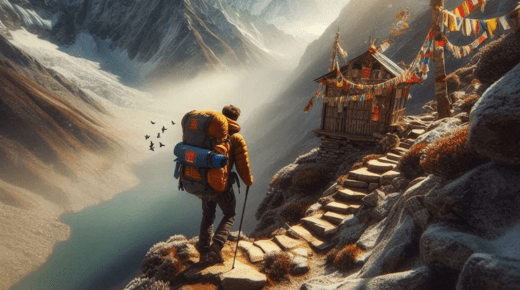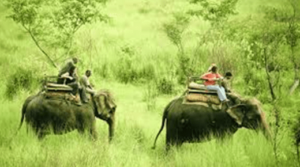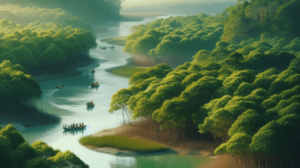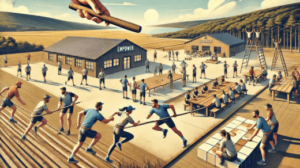The expedition of trekking to Everest Base Camp and Gokyo Lakes is a dream destination for many; nevertheless, high-altitude trekking poses challenges that require thoughtful planning and preparation. And that Sherpa experience is the unsung hero of the trek that you get through that not only proves you to survive but also thrive in this stunning wilderness. Another of the most crucial Sherpa trekking secrets is terrain knowledge. The trails leading to Everest Base Camp and Gokyo Lakes are both rugged and strenuous, with steep ascents, unpredictable weather, and occasional avalanches. Sherpas know these trails intimately, the nuances of every bend, rock, and high-altitude pass. Their expertise enables them to direct trekkers in a safe and efficient manner, regardless of the severity of the conditions.
Especially, acclimatization is another important secret. They are taught and trained on how to handle altitude sickness, which is also an important aspect when it comes to how to keep trekkers healthy. With a calculated regimen of slow ascent and scheduled rest days, the Sherpas allow trekkers to acclimatize to changing air conditions, almost eliminating the chances of altitude sickness. One of their tried-and-tested strategies is the “climb high, sleep low” technique, which enables trekkers to spend the day at higher altitudes and to descend to lower elevations to sleep. But this slow approach is key to a successful trek.
The Sherpas also focus on hydration and nutrition. When you’re at high altitudes, it’s easy to not take into account just how much water and food your body requires. They remind trekkers to drink lots of water and eat high-energy foods to keep stamina.
Most importantly, the Sherpa philosophy of trekking is one of revering the natural world and the culture around it. The intimate connection they share with the land makes Sherpas the best option to take trekkers to experience the Himalayas in their purest essence, enlightening them to cherish the journey beyond the physicality of it by immersing in the spiritual and cultural fabric of the mountains.
The Sherpa: The Expert Guide for Himalayan Adventures
They are the people who truly make climbing and trekking in the Himalayas possible, offering invaluable knowledge, guidance, and support along the way. Sherpas are from the Solu-Khumbu region of Nepal, and they have an instinctive knowledge of the terrain, climate, and culture of the Himalayas. Their exceptional skills in maneuvering through the harsh terrains of Mount Everest and nearby mountains make them indispensable partners for trekkers intending to ascend to Everest Base Camp or Gokyo Lakes. In addition to their outstanding physical endurance, Sherpas carry a deep cultural and historical knowledge of the region, providing trekkers with not only trails to reach their summits, but meaning behind the places they see along the way. Their role, however, is much more than simply showing you the way—they also protect, mentor, and serve as critical resources for trekkers providing knowledge on safe passage, local customs, and the rigors of the high-altitude region. The sirdar, a type of leader in the specific practice of trekking, is an expert who distinguishes a safe, smooth trek from a treacherous excursion, and there is no adventure in the heart of the Himalayas without one.
About Everest Base Camp and Gokyo Lakes Trails
EBC Trek and Gokyo Lakes treks are two of the most preferred trekking paths in the world and both offer trekkers a unique experience. The Everest Base Camp trek is a slightly more traditional walk that guides trekkers through Sherpa villages, forests, and monasteries to reach the true base camp at the foot of Mount Everest. The hike offers stunning views of Everest, Lhotse, and the Khumbu Icefall. In contrast, the Gokyo Lakes trek gives a quieter, more peaceful experience. The trek also leads past the peaceful Gokyo Lakes, a chain of glacial lakes which is bordered by high peaks, and spanning As heavy as Cho Oyu. The Gokyo Lakes trek also takes you over Gokyo Ri, which I’d argue provides the best panoramic views of the Everest massif (peaks of Makalu, Lhots,e and Everest). Both treks offer stunning views of the Himalayas, but the Everest Base Camp trek is more crowded while the Gokyo Lakes trek is a more peaceful, off-the-beaten-path experience. Although each route has its own challenges, rewards, and beautiful scenery, trekkers can select one based on their interests and experience.
The Lay of the Land: A Sherpa’s Guide
Both the Everest Base Camp and the Gokyo Lakes treks demand hours of uphill and downhill walking through rocky, unstable terrain—high-altitude treks, like these, require knowledge as well as physical endurance. The trail becomes a greater test from the moment trekkers leave Lukla, with rocky, uneven ground, steep ascents, and exposed ridges. One of the top tips that a Sherpa guide would give trekkers is to pace themselves and take frequent rest breaks. The terrain can be deceptive, and it’s easy to overdo it early, resulting in fatigue or altitude sickness. This is important as Sherpas emphasize to trekkers to go at a steady pace and not over-hurry the journey. Conditions at high altitudes tend to make trekking more arduous, so it’s important to walk slowly, especially as the altitude increases. Trekking poles are a great aid for keeping steady on rocky or uneven terrain and they reduce some of the strain on your knees while descending. Sherpas also offer advice on appropriate footwear — sturdy, comfortable boots aren’t just for preventing blisters, but washing out your ankles for the often rocky environment. Finally, it’s really important to stay hydrated and pay attention to the weather. The Himalayas are wholly unpredictable, after all, and a Sherpa’s knowledge of local conditions is the most important tool for responding to sudden changes in weather or terrain and keeping trekkers safe and ready for the next challenge.
Tips for Adjusting to High-Altitude Living
Acclimatization is a key factor when trekking at altitude, especially when attempting the Everest Base Camp or Gokyo Lakes trek. When climbers get to high altitudes, the air is thinner, and the body needs to acclimatize to less oxygen. When trekkers don’t have time to acclimatize, they can develop altitude sickness, which can range from mild symptoms such as headaches to severe, potentially deadly conditions. Sherpas stresses the need to take time to acclimatize, to have the body gain altitude over a slow process. Among the most efficient acclimatization tactics is to spend rest days at strategic stops along the route, like Namche Bazaar and Dingboche, where trekkers can ascend to a higher elevation during the day and then return to a lower one to sleep. This process encourages the production of red blood cells, improving the amount of oxygen sent to the body. The “climb high, sleep low” strategy is one that Sherpas live by as it prevents the body from being overwhelmed with thin air. Moreover, drinking plenty of water and consuming a balanced meal can also help in the body’s adaptational process. They also advise watching for symptoms of altitude sickness and do not hesitate to descend when that is the appropriate course of action. By employing these acclimatization techniques, trekkers can effectively deal with the rigors of high-altitude trekking, improving the chances of a pleasant and safe trip.
The Best Time to Trek – A Sherpa’s Point of View
Everest Base Camp via Gokyo Lakes When is the best time for Everest Base Camp or Gokyo Lakes? Sherpas say the best times to do these treks are during pre-monsoon (spring) and post-monsoon (autumn) seasons. With stable weather conditions, clear skies, and temperatures in the mid-range, spring (between March and May) is an ideal trekking season. The trails are relatively less crowded compared to the autumn season, and the region’s flora is in perfect bloom during this period which makes the trek a picturesque treat. The fall — from late September to November — is also a good time to visit, as the weather is stable and the skies are usually clear. But the fall season is usually busier, with more climbers and trekkers heading to Everest. The temperatures are more manageable in both seasons, and the risk of extreme weather is lower, making your trek more comfortable. Sherpas generally recommend against trekking during the winter months, because temperatures can plummet and trails become sheeted with ice, rendering them treacherous. The monsoon season (June to August) should also be avoided because of heavy rainfall, landslides, and poor visibility. Trekking during the best seasons also ensures that you can witness the Himalayan mountains in better weather conditions.
Scenic Spots and Views: Hidden Gems Along the Trails
While the Everest Base Camp and Gokyo Lakes treks are famous for their stunning vistas of Mount Everest and surrounding mountains, many hidden gems can be discovered during the journey there. They often take trekkers to less popular places with beautiful views where there are fewer crowds. Some lesser-known spots are even more beautiful than what you might expect. This is where trekkers are rewarded with some of the most amazing panoramas of Everest, Lhotse, and Ama Dablam. This calm area is an ideal place to rest and ponder the walk. A key highlight of the Gokyo Lakes trek is the tranquil Gokyo Ri, an under-visited viewpoint offering one of the most incredible 360-degree views of the Everest massif, Cho Oyu, and Makalu. Sherpas typically lead trekkers out to these viewing spots at sunrise when the mountains are aglow with soft morning light, an incredible experience. On the way to Everest Base Camp, trekkers also encounter meaningful solitude at the remote village of Dingboche, where the roof of the world gives way to miles and miles of breathtaking valleys set against a skyline dominated by snow-capped peaks. Such untouched quiet sections, that would get missed by most of the trekkers come as a chance to spend some quality time with the untouched fauna of the Himalayas.
Inspiring Wisdom From a Journey of Youth and Discovery
EBC Cho La Pass Trek Here are some of the challenges that we face while trekking to Everest Base Camp and Gokyo Lakes. It ranges from steep uphill pushes to rocky descents, often exacerbated by altitude, which is one of the most frequent challenges. To do this, trekkers must walk slowly, taking many breaks to combat fatigue. Weather in the Himalayas is unpredictable too, another challenge. You may find things difficult with sudden storms or extreme temperatures. Be prepared for all weather conditions by packing appropriate gear like waterproof clothing, layers for warmth, and durable footwear. High Altitude Environment is another challenge. *(At altitudes higher than 4,000 meters, air pressure is lower, meaning that there’s less oxygen in a given volume of air to breathe. The result can be breathlessness, dizziness, and fatigue. The best way to avoid altitude sickness is by slowly ascending and taking rest days to acclimatize. Finally, we have sore feet after days of trekking in remote areas with little to no infrastructure. Despite how the game is going, you might be battling with fatigue, which requires a mentally tough and upbeat attitude to work through. With the right strategies and awareness of potential challenges, trekkers can look forward to the rewards of completing these iconic treks.
Gear and packing essentials for the trek
Gokyo and Everest Base Camp Trek Packing the right gear for Everest base camp/ Gokyo Lakes trekking is vital to ensuring you are comfortable, safe, and have a successful trek. Packing for all weather is a must due to the harsh conditions of the Himalayas. Individually start with trails and high-quality trekking boots that provide proper support for rocky and uneven trails. You will want to layer, so pack moisture-wicking base layers, fleece or down jackets for warmth, and a waterproof outer layer to guard against rain and wind. Remember a warm sleeping bag rated for below-freezing conditions; nighttime temperatures can plummet. For accessories: the essentials include a hat, gloves, sunglasses, and a headlamp (and a good-quality pack to carry the lot comfortably). Other essential items include hydration systems, like water bottles or hydration bladders, to keep you hydrated throughout the trek, as well as water purification tablets or filters to ensure you have access to clean water along your trail. If you are trekking in elevated areas, it is recommended to carry a trekking pole to aid in stability, mainly on steep ascents and descents. So are a first aid kit, sunscreen, and UV lip balm. Make sure to bring essential documents like permits and identification. By adhering to these packing tips and keeping your gear organized, you’ll be ready to meet the challenges of the trek head-on.
How Sherpas Support Safety and Success
The Sherpa form an integral part of the expedition and play a vital role in ensuring the safety and success of all trekkers choosing to complete the Everest Base Camp and Gokyo Lakes treks. Being native guides of the Khumbu region, Sherpas possess unparalleled knowledge of the area, and the challenging landscape of the Himalayas. Their in-depth knowledge of the terrain also ensures that hikers remain on course, sidestepping potential dangers like avalanches or loose ground. Trekking at high altitudes, which is vital for acclimatization, is also part of the training of the Sherpas. They keep a close watch on trekkers’ health and adapt the pace and itinerary so that altitude sickness is a rare occurrence. But beyond their physical guidance, Sherpas offer logistical support, including navigation, camp arrangements, and even dealing with emergencies. The knowledge they possess about weather patterns and conditions is life-saving, as regimens of sudden storms or temperature changes to the mountains are a regular feature. In addition to their practical role, Sherpas provide cultural and spiritual insight into the Himalayan region, adding depth to the trekking experience. They know the customs, traditions, and sacred sites of the Sherpa community, which connect a deeper meaning to the journey. When you have a Sherpa by your side, you don’t just have a guide who cares for your safety; a Sherpa not only ensures your security but also adds depth to your trek with their knowledge and understanding of the area.
Cultural Tip: Sherpa Culture and the Local Communities
The Sherpa about culture in Everest EBC and Gokyo Lakes trekking The Sherpa are the other essential aspects of the Everest Base Camp on the trekking as they are a local ethnic community that provides trekkers about the amazing and rich cultural heritage to gorge them. The Khumbu region is also home to the Sherpas, a people of Tibetan descent who have resided in the Khumbu region for centuries and whose traditions and way of life have developed the trekking routes that so many adventurers follow today. During the journey, the trekkers will come across many Sherpa ethnic practices, including their deep-rooted Buddhist religion. There are a number of villages along the trail with monasteries and stupas where trekkers can witness Buddhist prayer rituals, watch colorful prayer flags blowing in the wind, and visit holy places. Traditional Sherpa food, like dal bhat (lentil soup and rice), is served and guests can experience the warmth of Sherpa hospitality.
Many of the Sherpa’s practices are rooted in sustainability and respect for nature, and their understanding of the lay of the land is deep-rooted and spiritual. And they still teach trekkers how to coexist in harmony with the mountains, sharing wisdom about the region’s flora and fauna. Here’s an example of what we have: You are hiking through the Khumbu and learning about Sherpa traditions, and these cultural aspects shine a light on the importance of cultural preservation and mutual respect with communities. Alongside the physical journey, these significant cultural insights cultivate a deep-rooted connection to the mountains that makes the experience transcend mere travel and reach a true spiritual journey within.
Symptoms of Altitude Sickness and How to Deal with It: Prevention
One of the most notable dangers faced by trekkers going to Everest Base Camp and Gokyo Lakes is altitude sickness. The signs can range from mild headaches and nausea to more severe cases of dizziness, shortness of breath, and confusion. The best way to prevent altitude sickness is to allow yourself to acclimatize gradually. Trekking slowly, with rest days woven into the itinerary, gives the body time to acclimate to the dwindling oxygen levels. The basic tenet is “climb high, sleep low,” which means hiking to higher elevations during the day but descending to lower altitudes at night to sleep. This allows your body to gradually acclimatize to the altitude without straining itself too much. Read more about “Gimkit Hacks”
Proper hydration is also a key factor in avoiding altitude sickness. Combined with altitude, dehydration can make the effects much worse, which is why trekkers should try to drink as much water as possible throughout the day. Stay away from alcohol and caffeine as these beverages can add to dehydration. Eating low-energy, nutrient-lean foods will help with stamina to counter fatigue. Alongside these tactics, is crucial to be aware of early symptoms of altitude sickness, such as a headache or dizziness. If any of these symptoms occur, one should immediately descend to a lower altitude and seek medical assistance if necessary. Sherpa guides are trained to recognize and deal with altitude sickness and will keep a close eye on trekkers. As long as you heed these precautions and follow your body, you’ll reduce the risk and keep your journey a pleasurable experience.
Final Thoughts: Attain Your Trek Goal with these Sherpa Secrets
Cho La Pass Gokyo Trek itinerary Sherpas are inarguably crucial in regard to the often most harrowing and gratifying time field visit of Everest Base Camp and Gokyo Lakes. They are the best of the best, leading the way through the rugged landscape, monitoring for altitude sickness, and safeguarding trekkers. Sherpas are there to keep an eye on the trekker’s speed, acclimatization, and hydration in order to minimize the risk of altitude sickness and enhance the chances of successfully completing the journey. I enjoy sharing the cultural stories of the region along the way — its traditions, spirituality, and natural beauty — that only a Sherpa can share.
After physical preparation for this arduous journey, the mental fortitude needed for such a strenuous hike is not to be ignored. Sherpas also help trekkers develop this resilience by encouraging a positive mindset and providing companionship in hard times. The knowledge and experience of someone who has a deep connection with the land, cultural traditions, and spiritual practices of their people imbibe trekkers with a holistic perspective on the trek itself. With the right preparation, the guidance of a Sherpa guide, and an open mind, an expedition to Everest Base Camp and Gokyo Lakes can turn into a transformative experience and stay in your thoughts long after you’ve returned home. Welcome to the land of Sherpas, where their knowledge, wisdom, and unwavering support will make this incredible adventure truly unforgettable.





